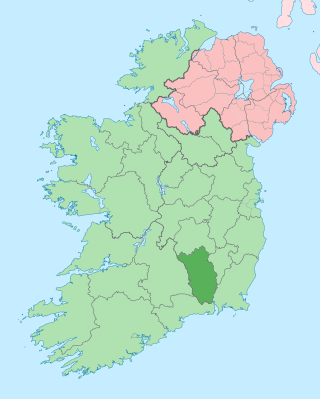
County Kilkenny is a county in Ireland. It is in the province of Leinster and is part of the Southern Region. It is named after the city of Kilkenny. Kilkenny County Council is the local authority for the county. At the 2022 census the population of the county was 103,685. The county was based on the historic Gaelic kingdom of Ossory (Osraighe), which was coterminous with the Diocese of Ossory.
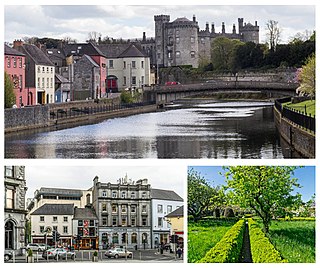
Kilkenny is a city in County Kilkenny, Ireland. It is located in the South-East Region and in the province of Leinster. It is built on both banks of the River Nore. The 2022 census gave the population of Kilkenny as 27,184.

Graiguenamanagh or Graignamanagh is a town on the River Barrow in County Kilkenny, Ireland. Part of the settlement, known as Tinnahinch, is on the County Carlow side of the river, and Carlow County Council refers to the whole village as "Graiguenamanagh-Tinnahinch". Also combined for census purposes, as of the 2016 census, Graiguenamanagh-Tinnahinch had a population of 1,475 people.
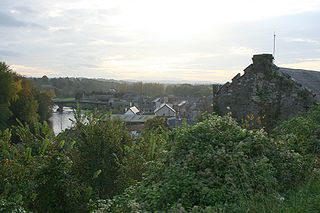
Thomastown, historically known as Grennan, is a town in County Kilkenny in the province of Leinster in the south-east of Ireland. It is a market town along a stretch of the River Nore which is known for its salmon and trout, with a number of historical landmarks in the vicinity. Visitor attractions include Jerpoint Abbey, Kilfane Glen gardens, and Mount Juliet Golf Course.
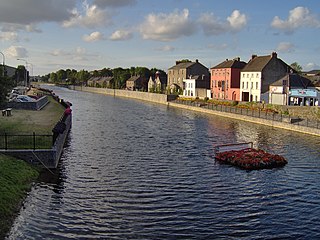
The River Nore is one of the principal rivers in the South-East Region of Ireland. The 140-kilometre-long (87 mi) river drains approximately 2,530 square kilometres (977 sq mi) of Leinster and Munster, that encompasses parts of three counties. Along with the River Suir and River Barrow, it is one of the constituent rivers of the group known as the Three Sisters.

Castlecomer is a town in the north of County Kilkenny, Ireland. It is positioned at the meeting of N78 and R694 roads about 16 km (9.9 mi) north of Kilkenny city. At the 2016 census of the Central Statistics Office, the town's population included 1,502 people.

Ballyragget is a small town on the river Nore in the north of County Kilkenny in Ireland. Ballyragget is on the N77 18 km (11 mi) north of Kilkenny. As of the 2016 census, it had a population of 1,082 people.
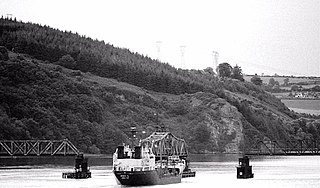
Barrow rail bridge,, is a pratt truss type of railway bridge that spans the river Barrow between County Kilkenny and County Wexford in the south east of Ireland. This rural landmark with a length of 2,131 ft (650 m) is the longest bridge on the river. It was second longest bridge in Ireland and the third longest rail bridge on the islands of Ireland & Great Britain. Designed by Sir Benjamin Baker and built by the firm of Sir William Arrol. It is known locally as Barrow Bridge.

Inistioge is a small village in County Kilkenny, Ireland. Historically, its name has been spelt as Ennistioge, Ennisteage, and in other ways. The village is situated on the River Nore, 25 kilometres (16 mi) southeast of Kilkenny.

Bennettsbridge is a village in County Kilkenny in Ireland. It is situated on the River Nore 6 kilometres (3.7 mi) south of Kilkenny city, in the centre of the county. Bennettsbridge is a census town, and has population of 745 as of the 2016 census.
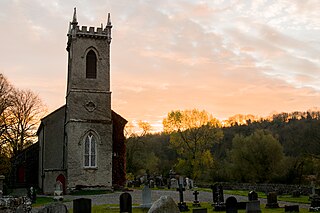
Saint Peter's Church, Ennisnag is a church of the United Dioceses of Cashel and Ossory and the ecclesiastical province of the United Provinces of Dublin and Cashel in the (Anglican) Church of Ireland. The church lies beside the Kings River, one mile north of Stoneyford village in County Kilkenny, Ireland. Located in the townland of Ennisnag, in the barony of Shillelogher.

Kilkenny marble or Kilkenny black marble is a fine-grained very dark grey carboniferous limestone found around County Kilkenny in Ireland in the "Butlersgrove Formation", a Lower Carboniferous limestone that contains fossils of brachiopods, gastropods, crinoids and corals. The first and main source was the "Black Quarry" in the townlands of Archersgrove and Gallowshill just south of Kilkenny city, which was used from the 17th to the 19th century. Kilkenny is nicknamed "the Marble City"; the footpaths of the city streets were paved with Kilkenny marble flagstones, which were highly polished with wear and glistened when wet.

Goresbridge is a small village located in the east of County Kilkenny, in the province of Leinster, Ireland. Goresbridge is named after a 1756 bridge, built by Colonel Ralph Gore, which provides a crossing of the River Barrow between County Kilkenny and County Carlow in the South-East region.

St Canice's Cathedral, also known as Kilkenny Cathedral, is a cathedral of the Church of Ireland in Kilkenny city, Ireland. It is in the ecclesiastical province of Dublin. Previously the cathedral of the Diocese of Ossory, it is now one of six cathedrals in the United Dioceses of Cashel and Ossory.

The tomb of Saint Nicholas is a slab effigy in low relief of an early 4th-century ecclesiastic popularly associated with Saint Nicholas of Myra in County Kilkenny, Ireland. While more probably a local priest from Jerpoint Abbey, it lies in the medieval lost town of Newtown Jerpoint, just west of the Cistercian Jerpoint Abbey.
Eland Mossom, Esq. M.P. was a lawyer, recorder of the City of Kilkenny, and representative in the Parliament of Ireland for the Borough of St Canice in Irishtown. He was the eldest son of Dean of Kilkenny Robert Mossom. He resided at Mount Eland, near Ballyraggett.
Sir Richard Shee was an Irish lawyer, politician, and Deputy Lord Treasurer of Ireland. He was a prominent member of the ruling class in Kilkenny city. He is best remembered for his influence on the architecture of Kilkenny city through his founding of the Shee Alms House in Rose Inn Street, Kilkenny, and for his ornate tomb in Saint Mary's Church.
John Bradley was a historian and archaeologist at NUI Maynooth. He grew up in Kilkenny and published many papers about his hometown.
Highhays is a townland and the location of a 14th-century Medieval pottery site. It was discovered in 2006 during excavations led by the late Emma Devine and Cóilín Ó Drisceoil. The excavations revealed a previously unknown suburb of Kilkenny which seemed to be the location of an industrial site dedicated to pottery. Amongst the 9,000 finds were a firing kiln, sherds of pottery, a ring-brooch, an ear scoop and decorated buckles. The type of pottery produced there has since been attributed the name Highhays Ware. It is found throughout Kilkenny city as well as other towns and castle sites in the Southeast of Ireland along the River Nore and River Barrow.

Highhays Ware is a term used for medieval pottery produced at the Highhays pottery site in Kilkenny, Ireland. It was previously referred to as "Kilkenny-type ware". The pottery found during the excavations at the site included jugs, cooking pots, storage jars, money boxes, parts of pottery like spouts and ridge tiles or parts thereof, in total "42 sherds of [...] pottery and 160 ridge-tile fragments" from the kiln alone.




















